A neon lamp is a glow lamp made up of a glass cover, fixed with a pair of segregated electrodes and containing an inert gas (neon or argon). The main application of a neon lamp is in the form of indicator lamps or pilot lamps.
When supplied with a low voltage, the resistance between the electrodes is so large that the neon practically behaves like a an open circuit.
However, when the voltage is increased gradually, at a certain specific level where the inert gas inside the neon glass begins ionizing and results in being extremely conductive.
Due to this the gas starts producing a radiant illumination from around the negative electrode.

In case the inert gas happens to be neon, the illumination is orange in color. For Argon gas which is not very common, the emitted light is blue.
How Neon Lamp Works
The working characteristic of a neon lamp can be witnessed in Fig. 10-1.
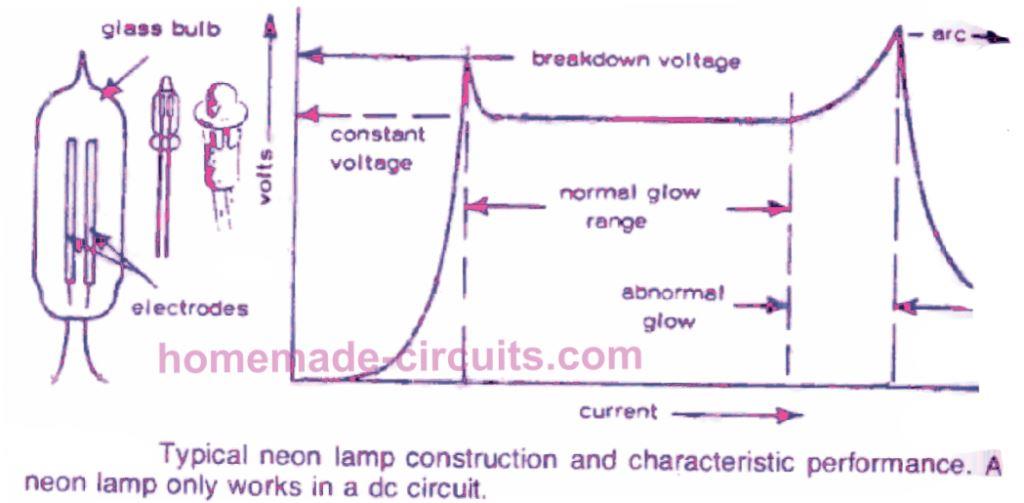
The voltage level which triggers the glowing effect in the neon bulb is termed as the initial breakdown voltage.
As soon as this breakdown level is struck, the bulb is triggered into "firing" (glowing) mode, and the voltage drop across the neon terminals stays practically fixed irrespective of any kind of increase in current in the circuit.
In addition, the glowing section inside the bulb increases as the supply current is increased, until a point in which the total area of the negative electrode is filled by the glow.
Any additional escalation in current may then drive the neon into an arcing situation, in which the glow illumination turns into a blue-white colored light over the negative electrode and begins producing rapid degradation of the lamp.
Hence, for you to illuminate a neon lamp efficiently, you must have sufficient voltage for the lamp to "fire," and, and then, ample series resistance in the circuit to be able to restrict the current to a level that will guarantee that the lamp stays running within the typical glowing section.
Since the neon resistance by itself is extremely small soon after it is fired, it needs a series resistor wit one of it supply lines, called a ballast resistor.
Neon Breakdown Voltage
Commonly the firing, or breakdown, voltage of a neon lamp could be anywhere between approximately 60 to 100 volts (or occasionally even greater). The continuous current rating is fairly minimal, generally between 0.1 and 10 milliamps.
The series resistor value is determined in accordance with the input supply voltage across which the neon may be attached to.
When it comes to neon lamps being controlled with a 220 volt (mains) supply, a 220 k resistor is usually a good value.
With regards to many commercial neon bulbs, the resistor could possibly be included in the body of the construction.
Without any precise info given, it may be supposed that a neon lamp may have simply no resistance while it is illuminated, but may have a drop of around 80 volts across its terminals.
How to Calculate Neon Resistor
A proper value for the neon ballast resistor could be determined by taking this benchmark into account, which is relevant to the precise supply voltage utilized across it, and presuming a "safe" current of, approximately 0.2 milliamps, as an example.
For 220 volt supply, resistor may have to lose 250 - 80 = 170 volts. Current through series resistor and neon bulb will be 0.2 mA. Therefore we can use the following Ohm's law formula for calculating the appropriate series resistor for the neon:
R = V/I = 170 / 0.0002 = 850,000 ohms or 850 k

This resistor value would be safe with the majority of commercial neon lamps. When the neon glow is not quite dazzling, the ballast resistor value could be reduced to drive the lamp higher across the typical glow range.
That said, the resistance must in no way be lowered too much which may cause the whole negative electrode to be engulfed by the hot glow, because this may indicate that the lamp is now inundated and getting close to the arcing mode.
One more issue regarding the power of the neon glow is that it may typically look a lot shiny in ambient light compared to in darkness.
Actually, in total darkness the illumination could be inconsistent and/or call for an increased breakdown voltage to initiate the lamp.
Some neons possess a tiny hint of radioactive gas mixed with the inert gas to promote ionization, in that case this kind of effect may not be visible.
WARNING: ALL THE CIRCUITS EXPLAINED BELOW INVOLVE MAINS AC POTENTIALS AND ARE THEREFORE EXTREMELY DANGEROUS TO TOUCH IN POWERED AND UNCOVERED CONDITION. USERS ARE RECOMMENDED TO EXERCISE EXTREME CAUTION WHILE HANDLING THESE CIRCUITS.
Simple Neon Bulb Circuits
In the above discussion we have elaborately understood the working and characteristic of this lamp. Now we will have some fun with these devices and learn how to build some simple neon lamp circuits for using in various decorative light effect applications.
Neon Lamp as a Constant Voltage Source
Due to the neon lamp's constant voltage features under standard light conditions, it could be applied as a voltage stabilizing unit.

Therefore, in the circuit displayed above, the output extracted from each side of the lamp might work like an origin of constant voltage, provided that the neon continues to work within the typical glowing region.
This voltage would be then identical to the minimal breakdown voltage of the lamp.
Neon Lamp Flasher Circuit
Using a neon lamp like a light flasher in a relaxation oscillator circuit can be seen in the image below.
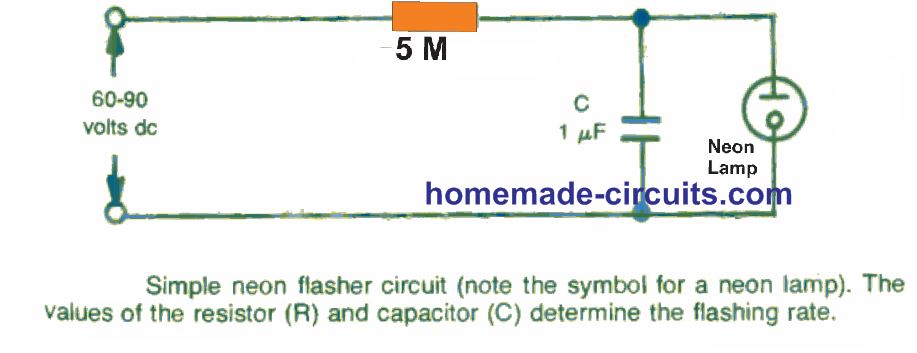
This includes a resistor (R) and capacitor (C) attached in series to a supply voltage of a dc voltage. A neon lamp is attached in parallel with the capacitor. This neon is applied as a visual indicator to show the functioning of the circuit.
The lamp almost performs like an open circuit until its firing voltage is reached, when it instantly switches current through it quite like a low value resistor and begins glowing.
The voltage supply for this current source therefore needs to be higher than that of the neon's breakdown voltage.
When this circuit is powered, the capacitor begins accumulating a charge with a rate determined by the resistor/capacitor RC time constant. The neon bulb gets a voltage supply equivalent to the charge developed across the capacitor terminals.
As soon as this voltage reaches the breakdown voltage of the lamp, it switches on and forces the capacitor to discharge via the gas inside the neon bulb, resulting in the neon to glow.
When the capacitor discharges fully, it inhibits any further current to pass through the lamp and thus it shuts down again until the capacitor has gathered another level charge equal to the firing voltage of the neon, and the cycle now keeps repeating.
Put simply, the neon lamp now keeps flashing or blinking at a frequency as decided by the values of the time constant components R and C.
Relaxation Oscillator

A modification in this design is indicated in the above diagram, by using a 1 megohm potentiometer working like a ballast resistor and a couple of 45 volt or four 22.5 volt dry batteries as the voltage input source.
The potentiometer is fine-tuned until the lamp illuminates. The pot is then rotated in the opposite direction until the neon glow merely fades out.
Allowing the potentiometer to be in this position, the neon must then begin blinking at different flashing rates as determined by the value of the selected capacitor.
Considering the values of the R and C in the diagram, the time constant for the circuit may be evaluated as follows:
T = 5 (megohms) x 0.1 (microfarads) = 0.5 seconds.
This is not specifically the true flashing rate of the neon lamp. It might require a period of several time constant (or fewer) for the capacitor voltage to accumulate upto the neon firing voltage.
This may be higher in case the turn-on voltage is over 63 % of the supply voltage; and may be smaller if the neon firing voltage spec is lower than 63 % of the supply voltage.
Additionally, it signifies that the blinking rate could be modified by changing the R or C component values, possibly by replacing various values worked out to provide an alternative time constant; or using a parallel attached resistor or capacitor.
Hooking up an identical resistor parallel with R, for instance, would likely make the flashing rate two times more (since adding similar resistors in parallel causes the total resistance to be reduced to half).
Attaching an identical value capacitor in parallel with the existing C would likely cause the flashing rate to become 50% slower. This type of circuit is referred to as a relaxation oscillator.
Random Multiple Neon Flasher
Replacing R with a variable resistor could enable adjustment for any specific desired flashing rate. This could also be further enhanced like a novelty light system by attaching an array of capacitor neon circuits, each having its own neon lamp in cascade as shown below.

Each of these RC network will enable a unique time constant. This may generate a random flashing of the neon across the entire circuit.
Neon Lamp Tone Generator
Another variation of a neon lamp application as an oscillator could be a relaxation oscillator circuit is shown in the figure below.
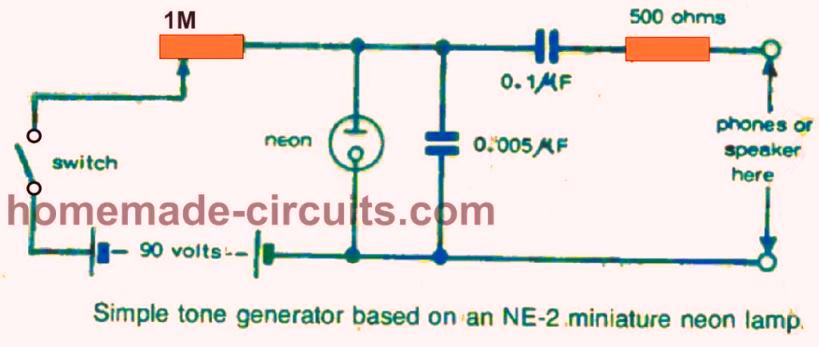
This can be a genuine signal generator circuit, whose output could be listened through headphones or perhaps a small loudspeaker, by suitably adjusting the variable tone potentiometer.
Neon flashers could be designed to function with random manner or sequentially. A sequential flasher circuit is displayed in Fig. 10-6.
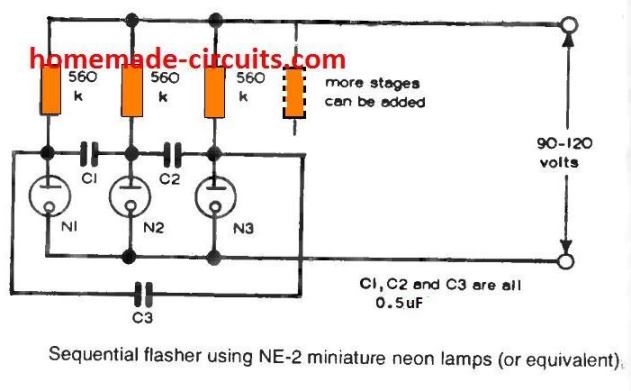
Additional stages could be included in this circuit, if required, by using the C3 connection to the very last stage.
Astable Neon Lamp Flasher
Lastly, an astable multivibrator circuit is revealed in the figure below, employing a pair of neon lamps.
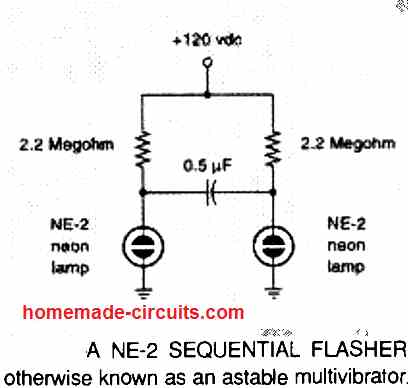
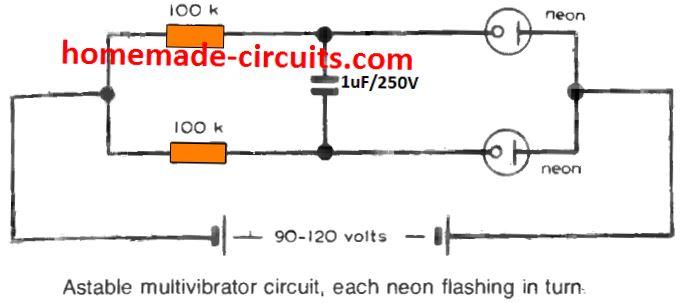
These neons will blink or flash on/off in sequence at a frequency decided by R1 and R2 (whose values must be identical) and C1.
As a basic instructions on flasher timing, increasing the ballast resistor value or the capacitor value in the relaxation oscillator circuit can reduce the flashing rate or the flashing frequency; and vice versa.
However, in order to protect the working life of a typical neon lamp, the ballast resistor value utilized must not be lower than approximately 100 k; and finest results in very simple relaxation oscillator circuits may often be accomplished by maintaining the capacitor value under 1 microfarad.
More Assorted Neon Circuits
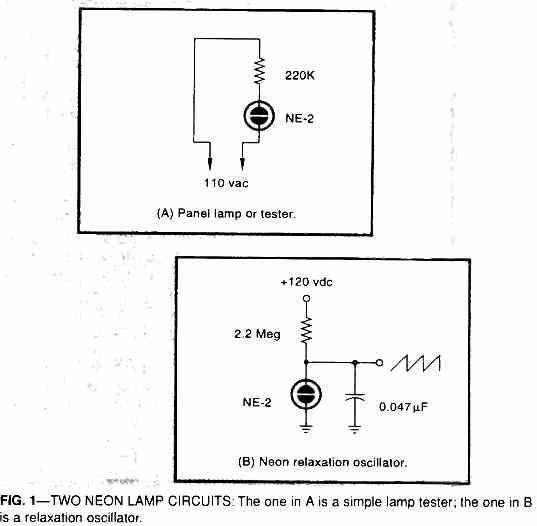
Neon Twinkling Star
The next neon lamp circuit provides a lovely neon glitter shine light outcome. In the past, I employed this design oftentimes for party decorations. Because of the dissimilarities in lamp firing limits, the illumination sequence results in essentially random therefore twinkling lights or "tiny blinking stars."
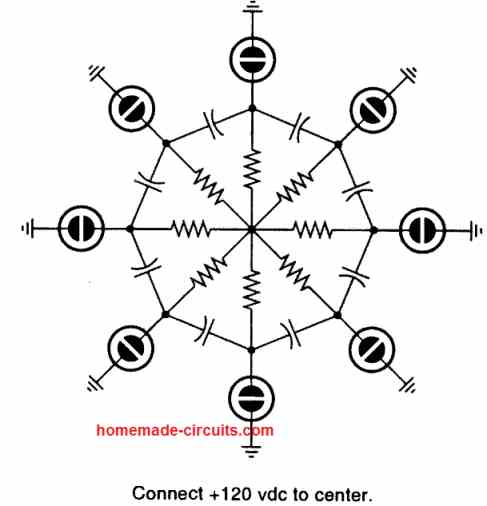
At any moment, a single (or sometimes a couple of) lamps tend to be illuminated allowing the capacitors their charging routes. When the capacitors charge, this exceeds the firing threshold for another neon, forcing it trigger ON. Due to a commutation impact, some lamp in the lit up mode subsequently turn off some other lamp which are previously lit up. These RC and neon networks are basically relaxation oscillators.
For these oscillators to work, the resistors and supply voltage all need to be selected to sit around the negative resistance portion of the NE-2 neon curve. This often takes place within a somewhat large value range. Some further experimentation might be required for something additionally extravagant.
Resistors having the value in the range of one to four megohm can be generally a good place to start. Precisely what is amazing is the fact that I still have no idea how to implement this kind of illumination pattern using LEDs which could turn out to be distantly as easy, as inexpensive, or as low in energy consumption.
Neon Lamp Driver Circuit
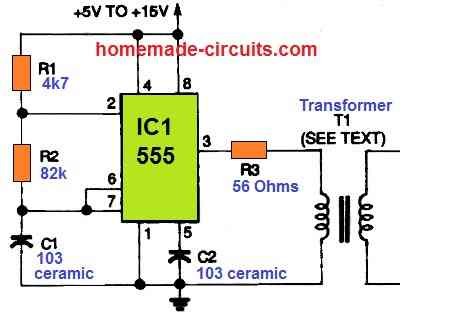
With a 5- to 15-volt DC supply, the circuit above may be used either to drive a neon light or for generating a low-current DC voltage of up to many hundred volts. The 555 is set up as a 3-kHz astable multivibrator, with its square-wave output supplied to the primary winding of the indicated transformer T1, via the resistor R3.
Transformer Details
T1 in this circuit can be a tiny audio transformer with appropriate turns ratio required to produce the necessary high output voltage. A 10 volt input supply and a transformer having a 1:20 turns ratio will provide an unloaded DC output of 200 volts peak in this circuit. With the help of a half-wave rectifier and a filter capacitor, this AC power may be readily converted to DC.
6 V Neon Flasher Circuit
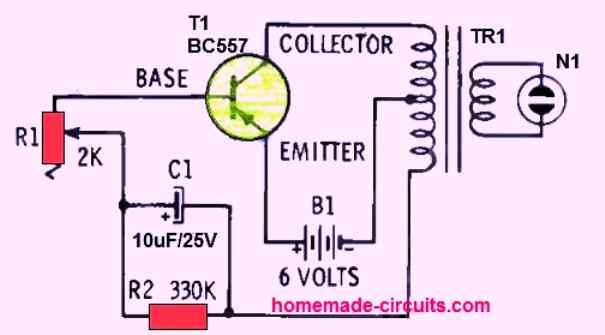
We've all seen those fascinating flashing neon signs, but getting the right voltage to "trigger" the bulb into light has proved to be a major challenge for do-it-yourself projects. You can make the neon N1 not only light up but also flash erratically using the unique arrangement illustrated in the above schematic, all while using a single 6 volt battery.
The main component of the circuit is, of course the transformer TR1. TR1 can be a 0-6V to 220V step-down transformer, which steps-up the six volts to 220 V in order to power the neon bulb.
This transformer does not need to be a specific type; it can be almost any available general type.
The setting of potentiometer R1 greatly affects how quickly the neon light flashes. You'll notice that there is no power switch in this circuit; this neon flasher circuit uses so little current that it can run on only four size -D flashlight batteries for virtually a lifetime.